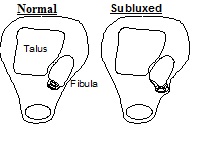

The peroneal tendons are sometimes injured during acute ankle sprains, but more commonly they have attritional tears as a result of chronic ankle instability and overuse injuries. In fact, peroneal tendon issues are the most common long-term complication of a bad ankle sprain. In some cases, the tendons will pop out from behind the ankle. These unstable or subluxating tendons are very challenging to manage non-surgically. While a fracture brace may temporarily relieve symptoms, upon return to pre-injury activity levels, symptoms will routinely recur.
When this happens, surgery is recommended. This surgery is performed on an outpatient basis. Below is an explanation of what to expect from peroneal tendon repair surgery. If you have questions about peroneal tendon surgery, contact Minnesota foot and ankle surgeon, Dr. Lance Silverman today!
Are you experiencing pain or discomfort in your ankle following a sprain? Have you been diagnosed with a peroneal tendon issue?
For more information about peroneal tendon surgery, keep reading.
What Happens Before Peroneal Tendon Surgery?
The surgical center will provide you with individualized advice in the days and weeks leading up to your operation. On the day of your surgery, the anesthesiologist will give you a regional anesthesia known as a popliteal nerve block. You will be placed on your stomach and a small needle will inject Novocain-like medication around the nerve in your leg. It gives complete pain relief that lasts for 12 to 36 hours. Patients report extraordinary satisfaction with this type of anesthesia. You will be given antibiotics just before surgery to help prevent infection.
What Happens During Peroneal Tendon Surgery?
During surgery you will undergo a light general anesthesia. When a concern of early arthritis exists, small (¼ inch) incisions are made on the ankle to permit ankle arthroscopy. The ankle joint is inspected and treated as necessary. An incision will be made along the outside of the ankle and the two tendons will be repaired. Ligament stabilization procedures are routinely required. With severe tendon tears, one tendon is transferred (sewn) onto the other. In the case of unstable tendons, the groove behind the ankle may be deepened. Finally, the wounds are closed and dressed.
What Happens After Peroneal Tendon Surgery?
You will be permitted to leave the surgical center once your anesthesiologist is satisfied that you have recovered. During this recovery time your family member may take your prescription to the nearest pharmacy. You will also be given crutches. Take your narcotic pain control medications before falling asleep or as you feel the “numbing” effect wearing off. Remember, post-operative pain is much easier to control with prevention. Call our office to schedule for the first follow-up appointment when you feel able.
Peroneal Tendon Repair General Recovery Timeline
This timeline is a general guideline. Your post-operative course may vary.
| Elevation | 23 hours / day for 3 days; then keep elevated as needed. Swelling may last over 4 months. |
| Motion | Move your toes and knee when the block resolves. This will decrease pain and swelling, and improve healing. Begin ankle motion at 2 weeks depending on several variables. Use the fracture boot for 4 more weeks (until 6 weeks post-op) while weight bearing to permit tendon healing. |
| Walking | Weight bearing begins as early as 3 days and may be restricted due to other concerns. Afterwards progress to a normal gait. |
| Bathing | Keep cast dry by using a Drypro. There are no restrictions after the cast is removed. |
| Pain Control | Expect to use strong narcotics for the first 3-5 days. Wean off as soon as you are comfortable using Tylenol or Motrin. |
| Work | Return depends on specific demands. It is safe to return to sedentary work at 10 days post-op. Return to heavy labor and sports will take over 3 months. |
| Driving | Patients with left foot surgery may drive an automatic transmission. Patients with right foot surgery must wait until healing is adequate and they feel safe. |
Routine Clinic Visits
**********If at any time during your post-operative period you notice any drainage or foul odor from your incision, a temperature of more than 100.4 degrees and/or increased swelling or tenderness, you should contact our office.
| 2 weeks | Remove cast and apply fracture brace; obtain a physical therapy prescription to start at 6 weeks post-op. |
| 3 months | Return if you have pain, other concerns, or per Dr. Silverman’s instructions. Minimal feelings of discomfort may linger, your overall comfort level improves over a year. |
For more helpful tips, check out these rehab exercise videos that will help you recover, or reach out to Dr. Silverman for more information!